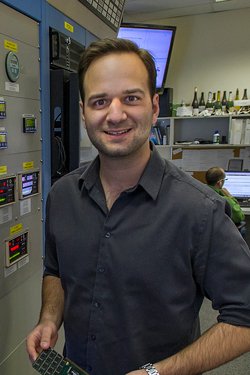Dennis Perepelitsa
2015 Regional Award Finalist — Post-Doc

Current Position:
Goldhaber Fellow, Department of Physics
Institution:
Brookhaven National Laboratory
Discipline:
Nuclear & Particle Physics

Current Position:
Goldhaber Fellow, Department of Physics
Institution:
Brookhaven National Laboratory
Discipline:
Nuclear & Particle Physics
Recognized for: Contributions to studies of high energy nuclear collisions with the ATLAS Collaboration at the LHC and the PHENIX Experiment at RHIC
Areas of Research Interest and Expertise: Nuclear Physics; High-Energy Physics; Hadronic Physics
Biography:
PhD, Physics, Columbia University
SB, Physics, MIT
SB, Mathematics & Computer Science, MIT
Dennis Perepelitsa works at the intersection of two exciting fields of physics, utilizing the tools of high-energy particle physics to explore new topics in the rapidly-evolving world of nuclear physics. Dr. Perepelitsa's research utilizes data from both hadron colliders, LHC based at CERN in Switzerland and RHIC at Brookhaven National Laboratory in New York, which are in operation today.
Dr. Perepelitsa's postdoctoral work has focused on exploring an unexpected feature of the proton, the simplest nucleus and the center of the ubiquitous hydrogen atom. Quantum mechanically, the wavefunction of a proton (which describes its composition in terms of the more fundamental quark and gluon particles) fluctuates constantly until it interacts with other matter. Dr. Perepelitsa’s research suggests that when protons are smashed at ultra-high speeds through much larger nuclei, they leave an experimentally measurable impression of the “size" of their wavefunction. The evidence indicates that protons whose energy is dominated by a single, high-energy quark or gluon are rather different than typical protons, which more democratically share their energy among their constituent particles. These protons can be described as “small" or spatially compact, and are less likely to interact with other particles. Dr. Perepelitsa continues to explore the ramifications of this surprising feature of everyday hadronic matter.
“My goal is to understand the novel features of ordinary matter in extraordinary circumstances. Through the ultra-relativistic collisions of large nuclei, we can take high resolution pictures of the fundamental structure of matter under extreme conditions.”
Key publications: